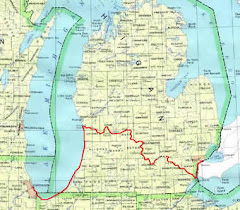Michigan Maritime Museum on Dugouts:
"Dugouts were the earliest form of watercraft used in the Great lakes region. They have been used here for thousands of years. It is believed the birch bark canoe developed somewhat later, although this is difficult to say with absolute certainty.

The oldest dugout discovered in the great Lakes region was found in a peat bog in Northern Ohio in 1976. Through radiocarbon dating analysis the 23-foot dugout was determined to be approximately 3,500 years old. This dugout canoe is currently displayed at the Cleveland Museum of Natural History (CMNH). (For an audio "tour" of the Ringler dugout at the CMNH: http://tinyurl.com/aep9u4)
Since Native Americans were present in the region as early as 10,000 to 12,000 years ago it is very likely that dugouts were built and used here earlier than 3,500 years ago. There is archaeological evidence of travel by natives to some islands in the Lakes region before that time. It is possible this travel was done in dugout canoes.
The historical records kept by European missionaries, explores and travelers in the Lakes region during the 1600's and 1700's indicate dugouts were being widely used along with the birch bark canoe. In fact, it appears that all groups which built and used bark canoes, built and used dugouts. Europeans sometimes referred to dugouts as "pirogues" (pronounced "pir-rog" with a long "o" and accent on the "rog").
Dugouts were used by native people as a form of transport for trade an communication between distant groups, hunting and fishing, and gathering aquatic plants and other resources from the regions biologically rich wetlands. Wild rice was often harvested this way."
The Maritime Museum's discussion adds other woods possibly used for dugout construction in the Great Lakes region including black walnut, red and white oak and aspen. I question these conclusions. Walnut and oak are hard to work and I doubt that many aspen got big enough to make a canoe log. They don't mention cottonwood which I know was used for dugout construction along the Missouri if not in Michigan.
They also discuss construction details and the technology of radiocarbon dating and the history of the dugouts they have on display.
Finally this is the end of the dugout series. I hope to see you at the Quiet Water Symposium.


.jpg)
.jpg)



.jpg)









.jpg)


.jpg)


